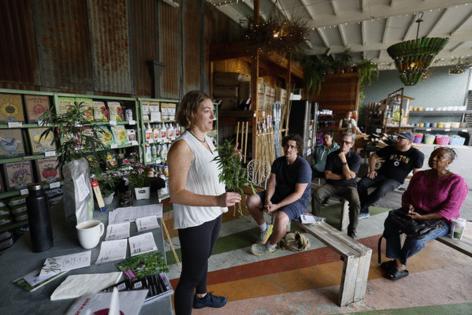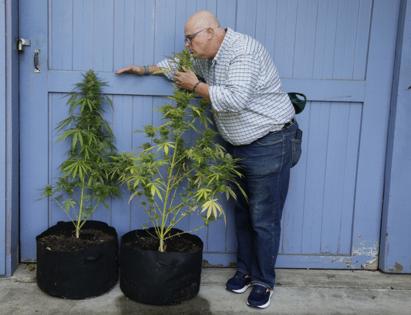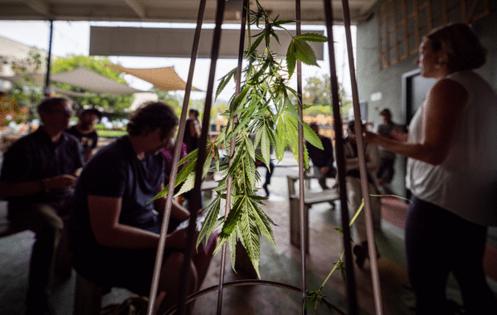You grew your first outdoor pot plant. Here are 4 things you need to do next
Published in Home and Consumer News
LOS ANGELES -- Back in the spring, Emily Gogol and Penny Barthel barnstormed L.A.-area nurseries and gardening centers with a series of USDA-sponsored Grow It From Home workshops that spread a simple message: Cultivating cannabis in your backyard is not only as easy as growing tomatoes, but Southern California turns out to be one of the best places on the planet to do it.
As a result, dozens of first-time outdoor ganja gardeners (including me) took the plunge and planted seeds. This is completely legal under California law, as long as you're 21 or older, have six or fewer plants, and keep them in a locked space that's not visible to the public. Other regulations vary according to where in the state you live.
Now, with the outdoor growing season that started in the spring drawing to a close (note: we're talking here about photoperiod plants whose flowering stage is triggered by the seasonal decrease in light), the Grow It From Home gang is back on the SoCal workshop circuit, this time with advice on how to properly harvest your leaf babies.
That's how I found myself at Fig Earth Supply in the Mount Washington neighborhood on a recent Saturday morning listening to Gogol, GIFH's co-founder and head gardener, help a dozen first-time pot parents navigate the process with practical, myth-busting, science-based advice. And though it's not quite as simple as plucking tomatoes off the vine, it's not as complicated as the interwebs make it seem.
Here's the straight dope (pun fully intended) on what you'll need to know to get the most out of your botanical bonanza when the time is right.
Harvest time: trichomes, stigmas and the 'squish test'
First things first: When is the right time to harvest that pot plant? According to Gogol, there are two considerations at play: what's going on in the plant's life and what's going on in yours.
"There's no perfect time to pick a tomato in your garden, and there's no perfect time to harvest your cannabis. So the 'when' is really between you and your plants," Gogol said. "And in reality, there's about a week or two of leeway. If you harvest on the early side, it means your plants are going to be lower yielding. If you wait and harvest a week or two later, it just means your plants will be higher yielding. Maybe you're about to go on vacation and you've got to get it done and it looks about right. ... Going into the first week of October here in L.A. [before harvesting] is totally fine."
As far as when a plant is in that two-week window, Gogol pointed to three key indicators. "One is the trichomes," she said, referring to the crystal-like dusting on the buds and some leaves that appears clear or milky white for most of the plant's growth cycle. (Fun fact: This is where the THC — the stuff that gets you high — is stored.) "If you have a jeweler's loupe, you can get a good look at [the trichomes]. When they're all or almost all brown, maybe think about harvesting."
The second thing Gogol said to look at are the antenna-like stigmas (sometimes incorrectly referred to as pistils, a term that more properly refers to the oval-shaped structure the stigmas emerge from). "You'll notice they'll start to die back and look brown and kind of dry," she said. "And that's another indicator that things are coming along."
"And the third indicator — and the one I find to be the most helpful — is the squish test," she said. "Every week, starting in September, just go out to your plant, grab one of the nugs [a.k.a. buds] and give it a squish. You'll notice that each week [the nug] will be getting thicker and less squishy. When it's really squishy, it's immature. You don't want spongy, you want firm. Depending on the variety you won't always get them rock-hard, but you definitely want firm. As a commercial farmer, the squish test is my go-to."
As for me and my harvest, Gogol popped by my two-plant garden for an in-person consult after the Fig Earth workshop. Her conclusion? My plant babies (both the Afternoon Punch cultivar from Gogol's Oregon Infinite Tree farm) — which had been transferred to outdoor fabric pots as seedlings on July 1— would probably be ready for the chopping block in about a week. Total time under the L.A. sun? 89 days.
Pre-harvest prep: Cool, dark and low humidity with a side of clothesline
While you're waiting for the telltale colors to change and the buds to firm up (which is to say, right now), Gogol suggested taking the time to do a little pre-harvest prep. That starts with finding someplace to dry your cannabis for about two weeks as you wait for the water content to slowly drop from 80% to around 12%. Whether it's a guest room, closet, garage or side porch, she says the key things to keep in mind are temperature, humidity and light.
"It should be 80 degrees or cooler," Gogol said. "And you want it dark. It doesn't have to be pitch black, but out of the sunlight. So something shaded like on a covered patio or under a tarp draped over garden hoops. And you want low humidity, anything below 60%. If you're drying in a place with a little higher humidity, like a basement or side yard that doesn't get a lot of airflow, put a fan on [the plants] if you're nervous. But the humidity here [in the L.A. area] is pretty good." (You can find outdoor humidity levels on most weather apps and check indoor humidity with an inexpensive hygrometer.)
Equipment-wise, all you'll need is a trusty pair of pruning shears ("You don't need any special 420 anything," she said, "a basic pair of Felco pruners that you probably already own will work") and some way to hang the plant branches while they dry. Here, too, Gogol said it doesn't need to be anything fancy: You can use anything from a clothesline to a folding laundry rack or collapsible mesh herb drying rack (some versions of the mesh herb dryers found on Amazon for around $22 include garden shears too).
Drying time: How moist is your nug center?
When the pre-harvest prep is done and you and your plant(s) are good to go, harvesting is as simple as snipping each bud-laden branch off the main stalk and hanging it — using one of the branch's natural notches as a hook — on your support structure of choice.
If you're drying plant branches with whole colas (colas are the tight clusters of buds you've been squishing for the last four weeks), Gogol says the drying phase should take anywhere from seven to 14 days, possibly longer. (This time can be decreased by about half if the buds are "shucked" — stripped off the branches into tiny popcorn-kernel sized nuglets in a single one-handed shucking motion.)
Gogol says there is only one surefire way to tell if your herb has properly dried. After a week, she suggests taking a nug off the branch, cutting it open and checking for moisture. "The water moves from the center out as it evaporates," she said, "so the wettest part of the nug is going to be in the middle. If it still feels wet, give it three more days, then grab some more nugs and cut them open. If all those nugs feel dry, maybe wait one more day and then you're done."
She added that the biggest mistake inexperienced ganja green thumbs make is to bag up their harvest before the buds have thoroughly dried, which can cause mold to develop. Therefore, she suggests opening your bagged (or jarred) herb up a few days later to check on it. "If it's moist in there, put it back into a mesh bag and let it dry for a couple more days, then check it again."
Proper storage: Think Mylar or Mason jars — but not Ziplocs
When it comes to storing your backyard bounty for the long haul, Gogol recommends putting it in airtight Mylar bags, Mason jars or tins — but to steer clear of the old-school Ziploc bag. "You can totally use Ziplocs if you want, but I don't recommend [them] because the plastic can absorb [some of] the flavors and terpenes."
Your bagged buds can be stored the way you might keep some of the other dried leaves you're familiar with. "Just like tea, it will bleach and turn yellow — and people say it might also get an off-flavor — if exposed to sunlight," she said. "So it's better to store it like food items: in a dark, cool place like a pantry."
Gogol's parting advice to first-time pot parents? "Cannabis is something that's precious. And it's something that's still illegal in many ways. But now that you're part of the cannabis gardening community and growing it at home, [you'll realize] it's abundant. You're going to have so much — about a pound of dried flower per plant — so you don't need to be afraid."
Except, perhaps, of overfilling your pantry.
©2024 Los Angeles Times. Visit at latimes.com. Distributed by Tribune Content Agency, LLC.













Comments